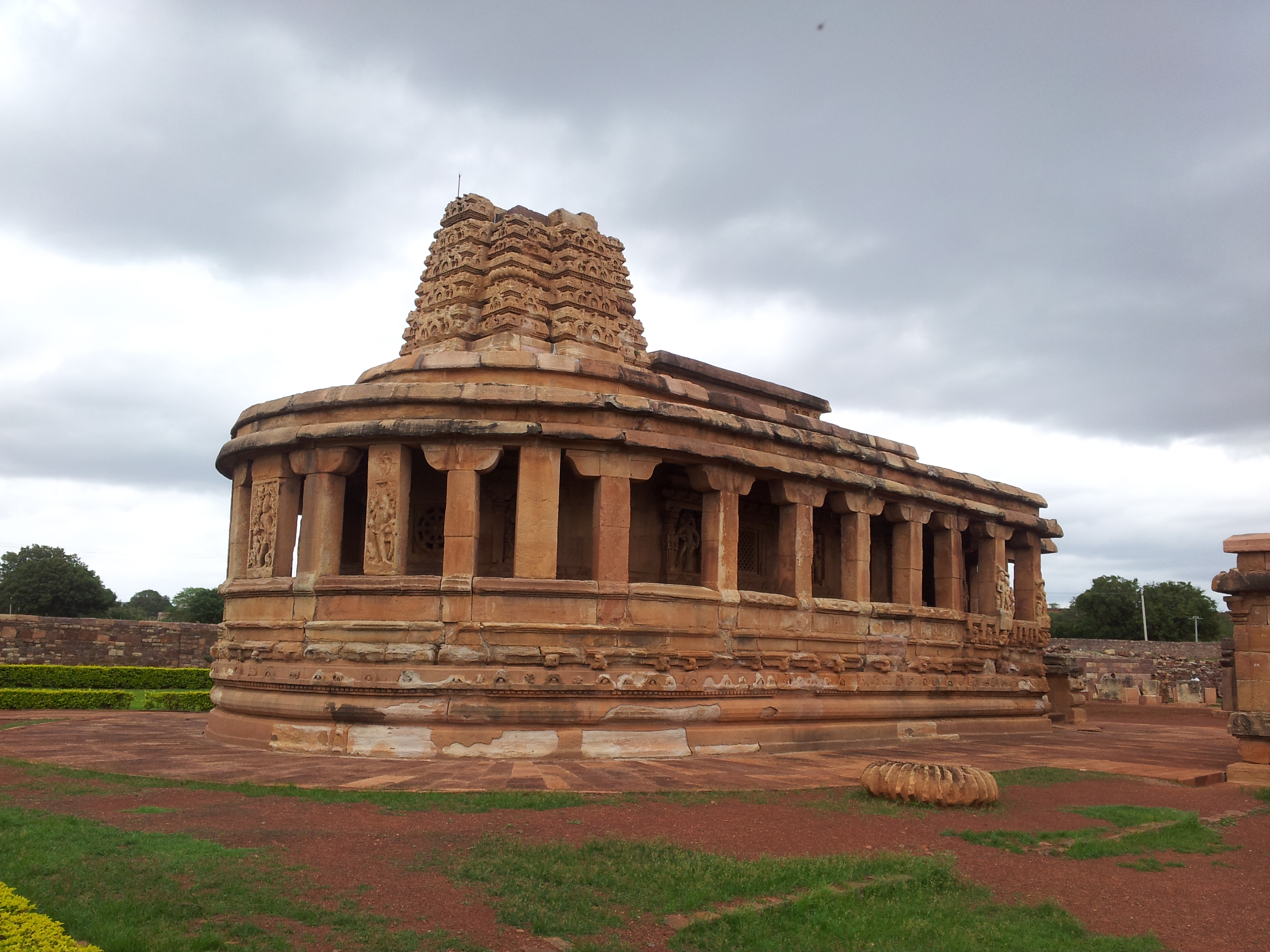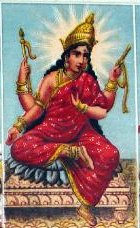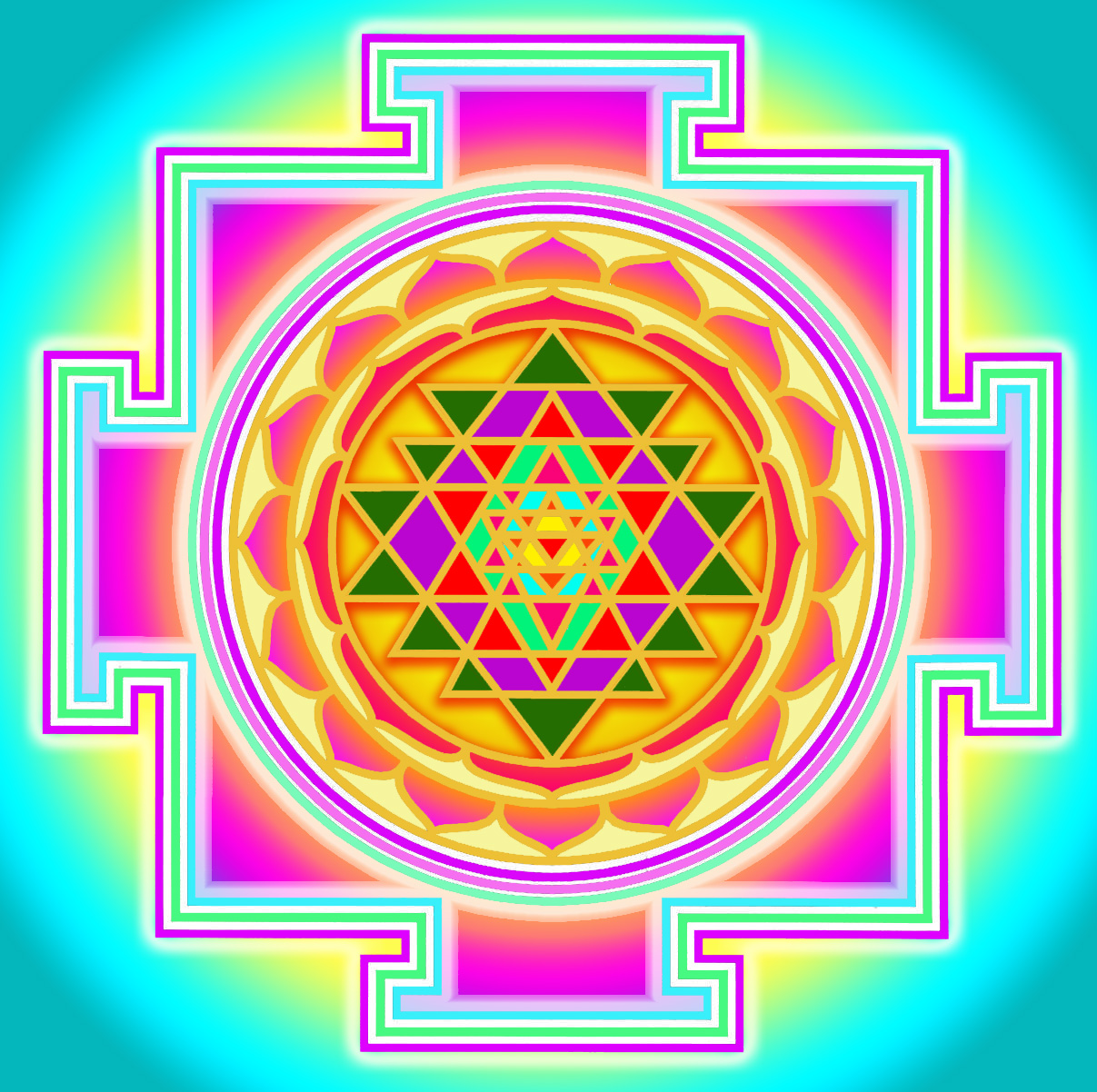|
Adi Shakti
Mahadevi ( sa, महादेवी, ), also referred to as Adi Parashakti, Adi Shakti, and Abhaya Shakti, is the supreme goddess in the Shaktism sect of Hinduism. According to this tradition, all Hindu goddesses are considered to be manifestations of this single great Goddess, who is comparable to the deities Vishnu and Shiva as Para Brahman. Vaishnavas consider her to be Lakshmi, Shaivas consider her to be Parvati, Durga, and Mahakali, while Shaktas consider her to be Durga, Tripura Sundari, Bhuvaneswari, and Kali. Author Helen T. Boursier says: "In Hindu philosophy, both Lakshmi and Parvati are identified with the great goddess Mahadevi and the Shakti or divine power". Vaishnavism The goddess Lakshmi is revered as Mahadevi in the Vaishnavite tradition, extolled to possess a thousand names and qualities such as The Bestower of Prosperity, The Lotus-eyed One, The Omniscient One, The One Who Meditates On The Ultimate Reality, as well as The One With The Cosmic Form. Var ... [...More Info...] [...Related Items...] OR: [Wikipedia] [Google] [Baidu] |
Devi Mahatmya
The ''Devi Mahatmya'' or ''Devi Mahatmyam'' ( sa, देवीमाहात्म्यम्, devīmāhātmyam, Glory of the Goddess) is a Hindu philosophical text describing the Goddess as the supreme power and creator of the universe. It is part of the Markandeya Purana. ''Devi Mahatmyam'' is also known as the ''Durgā Saptashatī'' () or Śata Chandī (शत् चण्डी). The text contains 700 verses arranged into 13 chapters. Along with ''Devi-Bhagavata Purana'' and Shakta Upanishads such as the Devi Upanishad, it is one of the most important texts of Shaktism (goddess) tradition within Hinduism. The ''Devi Mahatmyam'' describes a storied battle between good and evil, where the Devi manifesting as goddess Durga leads the forces of good against the demon Mahishasura—the goddess is very angry and ruthless, and the forces of good win. In peaceful prosperous times, states the text, the Devi manifests as Lakshmi, empowering creation and happiness. The verses of this ... [...More Info...] [...Related Items...] OR: [Wikipedia] [Google] [Baidu] |
Shakti
In Hinduism, especially Shaktism (a theological tradition of Hinduism), Shakti (Devanagari: शक्ति, IAST: Śakti; lit. "Energy, ability, strength, effort, power, capability") is the primordial cosmic energy, female in aspect, and represents the dynamic forces that are thought to move through the universe. She is thought of as creative, sustaining, as well as destructive, and is sometimes referred to as auspicious source energy. Shakti is sometimes personified as the creator goddess, and is known as "Adi Shakti" or "Adi Parashakti" ("inconceivableprimordial energy"). In Shaktism, Adi Parashakti is worshipped as the Supreme Being. On every plane of creation, energy manifests itself into all forms of matter; these are all thought to be infinite forms of Parashakti. She is described as ''anaadi'' (with no beginning, no ending) and ''nitya'' (forever). Origins One of the oldest representations of the goddess in India is in a triangular form. The Baghor stone, found in a ... [...More Info...] [...Related Items...] OR: [Wikipedia] [Google] [Baidu] |
Para Brahman
''Para Brahman'' ( sa, परब्रह्म, translit=parabrahma, translit-std=IAST) in Hindu philosophy is the "Supreme Brahman" that which is beyond all descriptions and conceptualisations. It is described as the formless (in the sense that it is devoid of Maya) that eternally pervades everything, everywhere in the universe and whatever is beyond. Param Brahma is conceptualised in diverse ways. In the Advaita Vedanta tradition, the Param Brahma is a synonym of ''nirguna brahman'', i.e., the attribute-less Absolute. Conversely, in Dvaita Vedanta and Vishistadvaita Vedanta traditions, the Param Brahma is defined as '' saguna brahman'', i.e., the Absolute with attributes. In Vaishnavism, Shaivism and Shaktism, Vishnu, Shiva and Adi Shakti respectively are Param Brahma. Mahaganapati is considered as Param Brahma by the Ganapatya sect. Kartikeya is considered as Param Brahma by the Kartikeya sect. Etymology ''Para'' is a Sanskrit word that means "higher" in some contexts, an ... [...More Info...] [...Related Items...] OR: [Wikipedia] [Google] [Baidu] |
Durga Ashtami
Durga Ashtami or Maha Ashtami is one of the most auspicious days of the five days long Durga Puja Festival celebrated in the honor of mother goddess Durga. Traditionally, the festival is observed for 10 days in Hindu households but the actual puja that takes place in the 'pandals' is held over a period of 5 days (starting from Shashthi). In India, fasting is undertaken by hindu people on this holy occasion. People also get together on this day to dance 'garba' and wear colourful clothes. This day is also known for 'Asthra Puja' (Worshiping Weapons) as on this day the weapons of goddess Durga are worshiped. The day is also known as Vira Ashtami as there are seen to use arms or martial arts on this day. Description The eight day of Navratri or Durga Puja celebrations is known as Durgashtami, or Durga Ashtami. It is also known as Mahashtami and is one of the most auspicious day according to Hinduism. It falls on bright lunar fortnight Ashtami tithi of Aswina month according to the ... [...More Info...] [...Related Items...] OR: [Wikipedia] [Google] [Baidu] |
Kali Puja
Kali Puja, also known as Shyama Puja or Mahanisha Puja, is a festival originating from the Indian subcontinent, dedicated to the Hindu goddess Kali. It is celebrated on the new moon day (Dipannita Amavasya) of the Hindu calendar month of Ashwayuja (according to the amanta tradition) or Kartika (according to the purnimanta tradition). The festival is especially popular in the regions of West Bengal, Mithila, Odisha, Assam, and Tripura, as well as the town of Titwala in Maharashtra, along with the neighbouring country of Bangladesh.. History The festival of Kali Puja is not an ancient one. Kali Puja was practically unknown before the 16th century; famous sage Krishnananda Agamavagisha first initiated Kali Puja. A late 17th-century devotional text, Kalika '' mangalkavya,'' also mentions an annual festival dedicated to Kali. In Bengal during the 18th century, King (Raja) Krishnachandra of Krishnanagar, Nadia, West Bengal also made this puja wide spread. Kali Puja gained popularit ... [...More Info...] [...Related Items...] OR: [Wikipedia] [Google] [Baidu] |
Lakshmi Puja
Lakshmi Puja () is a Hindu occasion for the veneration of Lakshmi, the goddess of prosperity and the supreme goddess of Vaishnavism. The occasion is celebrated on the amavasya (new moon day) in the Vikram Samvat Hindu calendar month of Ashwayuja (according to the amanta tradition) or Kartika (according to the purnimanta tradition), on the third day of Deepavali in most part of India. In Assam, Bengal, and Odisha, this puja is celebrated 5 days after Vijaya Dashami. According to popular belief, Lakshmi, the goddess of wealth and prosperity, and Vishnu's wife, visits her devotees, and bestows good fortune and her blessings upon them. To welcome the goddess, devotees clean their houses, decorate them with finery and lights, and prepare sweet treats and delicacies as offerings. Devotees believe that the happier Lakshmi is during her visit, the more she blesses the family with health and wealth. In Assam, Odisha, and parts of Bengal, ''Lokkhi Puja'' or ''Lakshmi Puja'' (লক ... [...More Info...] [...Related Items...] OR: [Wikipedia] [Google] [Baidu] |
Durga Puja
Durga Puja ( bn, দুর্গা পূজা), also known as Durgotsava or Sharodotsava, is an annual Hindu festival originating in the Indian subcontinent which reveres and pays homage to the Hindu goddess Durga and is also celebrated because of Durga's victory over Mahishasur. It is celebrated all over the world by the Hindu Bengali community but it is particularly popular and traditionally celebrated in the Indian states of West Bengal, Bihar, Assam, Tripura, Odisha, Jharkhand, Uttar Pradesh (eastern parts) and the country of Bangladesh. The festival is observed in the Indian calendar month of Ashwin, which corresponds to September–October in the Gregorian calendar. Durga Puja is a ten-day festival, of which the last five are of the most significance. The Puja (Hinduism), puja is performed in homes and public, the latter featuring a temporary stage and structural decorations (known as ''pandals''). The festival is also marked by scripture recitations, performance ar ... [...More Info...] [...Related Items...] OR: [Wikipedia] [Google] [Baidu] |
Vasanta Panchami
Vasant Panchami, also called Saraswati Puja in honor of the Hindu goddess Saraswati, is a festival that marks the preparation for the arrival of spring. The festival is celebrated in Indian religions in different ways depending on the region. Vasant Panchami also marks the start of preparation for Holika and Holi, which take place forty days later. The Vasant Utsava (festival) on Panchami is celebrated forty days before spring, because any season's transition period is 40 days, and after that, the season comes into full bloom. Nomenclature and date Vasant Panchami is celebrated every year on the fifth day of the bright half of the Hindu lunisolar calendar month of Magha, which typically falls in late January or February. Spring is known as the "King of all Seasons", so the festival commences forty days in advance. It is generally winter-like in northern India, and more spring-like in central and western parts of India on Vasant Panchami, which gives credence to the idea th ... [...More Info...] [...Related Items...] OR: [Wikipedia] [Google] [Baidu] |
Navaratri
Navaratri is an annual Hindu festival observed in the honour of the goddess Durga. It spans over nine nights (and ten days), first in the month of Chaitra (March/April of the Gregorian calendar), and again in the month of Sharada. It is observed for different reasons and celebrated differently in various parts of the Hindu Indian cultural sphere. Theoretically, there are four seasonal ''Navaratri''. However, in practice, it is the post-monsoon autumn festival called Sharada Navaratri. The festival is celebrated in the bright half of the Hindu calendar month Ashvin, which typically falls in the Gregorian months of September and October. Etymology and nomenclature The word ''Navaratri'' means 'nine nights' in Sanskrit, ''nava'' meaning nine and ''ratri'' meaning nights. Dates and celebrations In the eastern and northeastern states of India, the Durga Puja is synonymous with ''Navaratri'', wherein goddess Durga battles and emerges victorious over the buffalo demon Mahishasu ... [...More Info...] [...Related Items...] OR: [Wikipedia] [Google] [Baidu] |
Sri Yantra
The Sri Yantra, Shri Yantra, or Shri Chakra is a form of mystical diagram (''yantra'') used in the Shri Vidya school of Hinduism. It consists of nine interlocking triangles - four upward ones which represent Shiva, and five downward ones representing Shakti. All these surround the central point, the ''bindu''. These triangles represent the cosmos and the human body. Because of its nine triangles, Shri Yantra is also known as the ''Navayoni Chakra''. When the two-dimensional Shri Yantra is represented in three dimensions, it is called a ''Mahameru''. Mount Meru derives its name from this shape. In addition to Mount Meru, all other yantras derive from the Shri Yantra. Appearance In the 2009 issue of Brahmavidya (the journal of the Adyar Library), Subhash Kak argues that the description of Shri Yantra is identical to the ''yantra'' described in the Śrī Sūkta in the Rigveda. The Sri Yantra's 9 constituent triangles vary in size and shape and intersect to form 43 smaller triangles ... [...More Info...] [...Related Items...] OR: [Wikipedia] [Google] [Baidu] |
Bhuvaneshwari
Bhuvaneshvari (Sanskrit: भुवनेश्वरी, IAST: ''Bhuvaneśvarī'') is a Hindu goddess. She is the fourth amongst the ten Mahavidya goddesses in Shaktism, and one of the highest aspects of ''Mahadevi''. She is identified as Adi Parashakti in the Devi Bhagavatam. Etymology The word Bhuvaneshvari is a compound of the words ''Bhuvana Iśwari'', meaning "Goddess of the world" or "Queen of the universe", where the worlds are the ''tri-bhuvana'' or three regions of ''bhūḥ'' (Earth), ''bhuvaḥ'' (atmosphere) and ''svaḥ'' (Heavens). Forms According to the Devi Bhagavata Purana, the goddess offers the five manifestations of the Pancha Prakriti: # Durga # Lakshmi # Saraswati # Gayatri # Radha Temples There are several temples dedicated to Bhuvaneshvari across India. In South India most of the Srividhya tradition upasaka worship her. In Kerala she is also popular among Shaktas. * Sacred Adishakti Bhuvaneswari Devi Shakti Peetha temple in Bilkhet near Satpuli, Pau ... [...More Info...] [...Related Items...] OR: [Wikipedia] [Google] [Baidu] |
Tripura Sundari
Tripura Sundari (Sanskrit: त्रिपुरा सुन्दरी, IAST: Tripura Sundarī), also known as Rajarajeshwari, Shodashi, Kamakshi, and Lalita is a Hindu goddess, worshipped as a principal aspect of supreme goddess Mahadevi mainly venerated in Shaktism, the goddess-oriented sect of Hinduism. She is also one of the ten Mahavidyas. She is praised in many Shakta texts, with '' Lalita Sahasranama, Soundarya Lahari'' being the most popular one. She is known as Adi Parashakti in Lalitopakhyana of Brahmanda Purana. According to the Srikula tradition in Shaktism, Tripura Sundari is the foremost of the Mahavidyas, the supreme divinity of Hinduism and also the primary goddess of Sri Vidya. The Tripura Upanishad places her as the ultimate Shakti (energy, power) of the universe. She is described as the supreme consciousness, ruling from above Brahma, Vishnu, and Shiva. Kinsley says, "In one instance she is said to be sitting on Shiva's lap in the Kameshwara form, the 'Lor ... [...More Info...] [...Related Items...] OR: [Wikipedia] [Google] [Baidu] |






_(8638392628).jpg)


